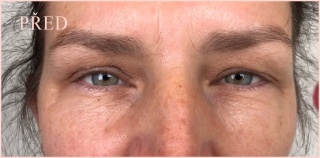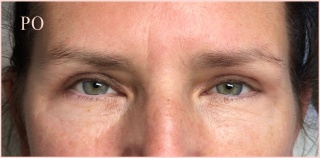Plastic surgery of the upper eyelid
Eyes are an important component of the overall aesthetic perception of the face, and they play a key role in perceiving its overall harmony. That’s why plastic surgery of the upper eyelids has become one of the most frequently performed facial cosmetic surgeries. But it is not just done for aesthetics. Excess skin on the upper eyelids can cause functional impairment, such as excess tears, burning eyes, red eyes, poor vision and even a reduced field of view.
The human eye is contained within the orbital cavity, surrounded by a fat pocket bordered by a fine connective sheath. This sheath loses its rigidity over time, and the fat pockets gradually push into the subcutaneous tissue of the eyelid. This results in a so-called fat prolapse, and so eye bags are formed. This process is influenced by a range of factors, from genetic effects to skin type, and also susceptibility to swelling, especially in thyroid and kidney disease.
The objective of plastic surgery of the eyelids is to remove excess skin and fat tissue pushing through underneath, which results in an older and more tired appearance.
Frequently Asked Questions
Who the operation is suitable for
Plastic surgery of the upper eyelids is suitable for women or men. The operation is most commonly performed for clients over 40 years of age, but it can be performed earlier where there is a particular anatomical predisposition.
The first and most fundamental step before deciding to undergo plastic surgery of the upper eyelids is an initial consultation. On the basis of an examination, the doctor will suggest the most suitable type of procedure. If this procedure suits you, the doctor will give you full details about the procedure, including anaesthesia method.
The surgery is performed under local anaesthetic. The operation can also be performed under general anaesthesia if the client or doctor prefers it.
Before the operation
Before plastic surgery of the upper eyelids, you need to undergo a pre-operation examination, which your general doctor will provide. This examination will include laboratory blood tests, including coagulation value, laboratory-determined liver function values, mineral content, etc. A cardiac function assessment is only needed for operations under general anaesthetic, or for patients over 40 years of age and patients with heart problems.
Before the operation, we do not recommend taking medicines such as Acylpyrin, Alnagon, Aspirin and Mironal, which may cause increased bleeding during and after the operation. Clients who take blood thinners (e.g. Warfarin) should consult with the doctor treating them on whether they should stop taking them temporarily.
On the day of the operation
On the day of the operation, you should arrive at the clinic at the agreed time. Bring with you your pre-operation examination results, which must include a statement from your general doctor that the operation is appropriate for you. The pre-operation examination must not date to earlier than 14 days prior to the operation.
Course of the operation
A surgical cut is made following a careful sketch so as to ensure it is hidden in the eyelid skin fold and the scar remains covered beneath natural skin folds within the upper eyelid orbital ridge. Subsequently, excess skin is removed, alongside extra orbicularis muscle in certain cases. After extraction of fat prolapses, the wound is carefully closed using a fine intradermal stitch. Finally, special plasters are placed on the wound.
Upper eyelid surgery takes around 45 minutes.
After the operation
After eyelid plastic surgery, wounds are covered with a thin plaster. Immediately after the operation, the client goes home with no major impact on their ability to see. The client should not drive a car, however, and as such we recommend someone take you home. Before leaving for home, the client will be informed about post-operative care at home.
During the post-operative period, it is a good idea to take things easy and apply cooling compresses to prevent excessive swelling and bruising. The most visible swelling will disappear if kept thoroughly cool within a few days. Swelling usually disappears completely within one to two weeks. It is a good idea to sleep with your head in a raised position and limit physical activities which might result in increased blood pressure for a week.
Specific instructions
During the first 24 hours, it is a good idea to apply cold compresses (cooling gels) to the eyelids over a sterile dressing for 30-minute periods, followed by a 30-minute break. You do not need to cool the eyelids overnight.
On day two following the operation, carefully remove the bandage from your eye. Leave the thin elastic plaster on the skin. It is important that this plaster not get wet for a period of 7 days, and that you continue cooling it by applying ice over an ironed handkerchief so that the plaster remains dry.
On day three following the operation, you should continue to cool the eyelids, but you need not do so to the same large degree. Swelling and bruising will appear on your eyelids after the operation, and these will remain for 2-3 weeks. This is natural and nothing to worry about.
On day seven after the operation, you should arrive at the clinic to get your stitches out. The plaster on your eyelids should remain there until the stitches are removed. If the plaster comes away before this, you should visit the clinic to reattach it. Once the stitches have been removed, you no longer need to cool the eyelids. Instead, continue applying an elastic bandage over a handkerchief only overnight. This prevents damage to the wounds while sleeping. Apply an elastic bandage overnight for at least the first 10 days following the operation.
On day 13 after the operation, you can begin with gentle massaging of the wounds. Gently press down on the wound with the tip of your finger, and apply pressure for around 30 seconds, then move your finger to another part of the wound. You should massage your wounds in this way a few times each day. You can use an unperfumed oil-rich cream or olive oil.
After surgery, you should avoid exposure to sunlight for a period of 2-3 months. It is also a good idea to protect your eyelids using a high SPF cream.
Ability to work
Clients can undertake undemanding office work from the third day after the operation, but you should expect significant swelling and bruising, which will remain for a period of around 1-2 weeks.
The final outcome of the surgery is seen after 4-8 weeks, once the swelling has gone completely and the scar should be almost invisible.

